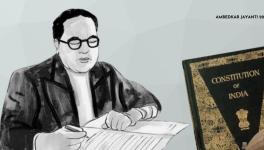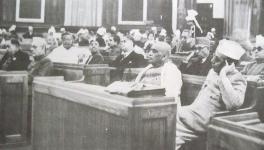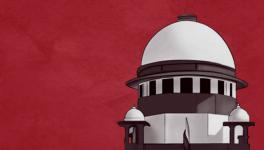What we Learn From how Demolitions in Jahangirpuri Played out on Twitter
On 16 April, Delhi’s Jahangirpuri locality witnessed violence as a Hindu religious procession chanting anti-Muslim slogans passed by a mosque. On the following Wednesday, in the same area, a Bharatiya Janata Party (BJP)-run civic body conducted an “anti-encroachment drive”. While the demolitions affected Muslim properties more, members of all communities of Jahangirpuri insisted they never got notices that their buildings were illegal. Then, despite a Supreme Court order to stop the demolitions, the drive continued for over an hour.
For all these reasons, the demolitions attracted much public debate and the social media site Twitter also became a site of discussion. However, the way the Twitter discourse unfolded this time was unusual. By design, platforms such as Twitter allow for wide participation but limit the scope for nuanced discussion. They strongly favour short messages, which subverts complex and important discussions. We saw this unfold all too clearly after the demolitions in Jahangirpuri.
From an analysis of tweets published between 19 and 20 April, it is evident that the Twitter framework saw one-sided dominance of narrative of the State machinery at the cost of citizens’ rights (in this case, to housing). Indeed, many spoke in defence of Muslims on Twitter, while others justified State’s action in the form of demolitions. For example, one hashtag against the demolitions was #StopBulldozingMuslimHouses. However, despite this, all nuances regarding the demolition were conveniently left out in order to perpetuate prevailing biases against Muslims.
Here is how it unfolded: No hashtag explicitly supporting State action could secure a place among the top trends. Instead, a good proportion of pro-government tweets were published under a neutral-sounding hashtag, #Bulldozer, which appeared between 19 and 20 April [retrieved on 25 April 2022].
#Bulldozer garnered around 20,700 tweets. It had 1,85,000 retweets, 6,26,000 likes and 36,000 replies, which came from 11,700 individual accounts. The hashtag and messages circulating within it were heavily skewed towards just a handful of Twitter accounts. These accounts predominately supported the State action of bulldozing homes.
Suppose we consider only the top twenty of the 20,700 total tweets (which amounts to about 0.01% of the tweets), arranged in descending order of retweets. Eleven of these top 20, coming from only eight individuals, accounted for 22.5% of all retweets, 23.8% of likes, and 20.3% of all replies under #Bulldozer.
Of the remaining nine (out of 20) top tweets, one was a parody, six were critical of the bulldozing of homes, and two were neutral news developments. Collectively, these nine tweets accounted for only 11.6% of the retweets in #Bulldozer. The six critical tweets were only 8.2% of the retweets.
In other words, the top tweets accounted for most of the retweets, and they mostly favoured the government’s actions in Jahangirpuri. This reveals an emerging Twitter trend wherein one side of a debate is supported while it appears to be either in the middle or holding a neutral position.
It is likely that those who supported State action in Jahangirpuri themselves initiated the #Bulldozer trend and were cognizant that they gave the hashtag a “neutral” tone. This, in some ways, can explain why it got a disproportionately large share of the conversation.
There are two possible explanations for this. First, an act as sudden and grave as demolitions (especially in a violence-affected area) cannot be defended with an extreme-sounding hashtag. So, support was extended to the State, but it wore the façade of neutrality. Two, by initiating a neutral-sounding trend, an external user whose support is being sought is not forced to take or pre-declare a position on the issue.
By contrast, the competing hashtag #StopBulldozingMuslimHouses clearly defines who the victim is and takes a side. Unlike a neutral-seeming theme, it cannot lull ambivalent users into believing a conversation is “general” or disassociated from a “political position”.
Only a neutral-sounding hashtag can sidestep the plight and cause of the victims of this demolition drive. It potentially aids the erasure from public memory of those who lost their homes and suffered during the communal disturbances of a week earlier.
It is worth elaborating that all eleven tweets (in Devanagari script) that supported State action were crafted as if devoid of political “blame-game” or clutter. They focused on what the act of bulldozing signified to Indians ‘as citizens’. For example, the razing of homes and establishments of Jahangirpuri residents was represented as a secular act and not targeting any religion. For example, a tweet said, “Bulldozers don’t see religion. They see illegal constructions”.
Some tweets did claim that the bulldozing targeted illegal constructions of “Bangladeshis” (“Not Muslim houses, only the illegal constructions of rioters in #Jahangirpuri are demolished using #Bulldozer and also to remove Illegal encroachment from roads & government land occupied by Bangladeshis.”). It was projected as a much-needed “cleanliness” drive. Stepping over the voice of neutrality, the bulldozer hashtag had tweets that claimed the demolitions would put an “end to pollution”, “destruction”, “terror and crime”. The terms are certainly offensive and “non-neutral”, but they make the demolitions seem like a vehicle of “justice” and “law”. There were also negative allusions to Kapil Sibal and Prashan Bhushan, who were shown as protectors of miscreants.
Furthermore, by messaging in a neutral (rather than extreme) tone, the extreme is—to borrow an argument from Prof Suhas Palshikar—occupying, controlling and shifting the “middle ground” in the digital space too. In this vein, the “cleanliness drive against illegal Bangladeshis” narrative fits into the slurs made in 2019 about Muslims. Further, when Aam Aadmi Party leaders commented that it is the BJP which has “settled Bangladeshis and Rohingyas”, they promoted the bias—an apt instance of how divisive narratives have been normalised.
Often, collective and activist-like conversations on Twitter get associated with a hashtag, which indicates a position or theme around which people can rally to create trends. A hashtag allows users to reach broader relevant audiences and is akin to voicing one’s opinion in the right room, as opposed to speaking out in a corridor. Generally, incidents like the demolitions at Jahangirpuri lead to at least three-sided debates—for, against, and a middle. The two extremes flow into the middle to influence and move people over to either extreme.
Influencing the middle is a sophisticated process, but the BJP is known for its well-oiled communication machinery. Recent allegations of its affiliates using software tools like TekFog confirms the vast reach of its IT cell. These authors have previously shown that many pro-government hashtags appeared they were concertedly created to saturate cyberspace with narratives that fit the government’s version of events. Sure, this is not limited to the BJP, all parties invest in defending their positions online, but the BJP far outweighs others in this field.
Steering ambiguous perceptions towards divisive extremes by constantly repeating farcical narratives within a seemingly secular repertoire will exacerbate social biases. Such practices have grave implications for India’s secular fabric and constitutional ethos. Now more than ever, we citizens need to revisit our history and politics to sincerely and meticulously understand ourselves and where we wish to go or achieve as a nation.
Vihang Jumle is a public policy student based in Berlin. Vignesh Karthik KR is a doctoral researcher at King’s India Institute, King’s College London. The views are personal.
Get the latest reports & analysis with people's perspective on Protests, movements & deep analytical videos, discussions of the current affairs in your Telegram app. Subscribe to NewsClick's Telegram channel & get Real-Time updates on stories, as they get published on our website.
























